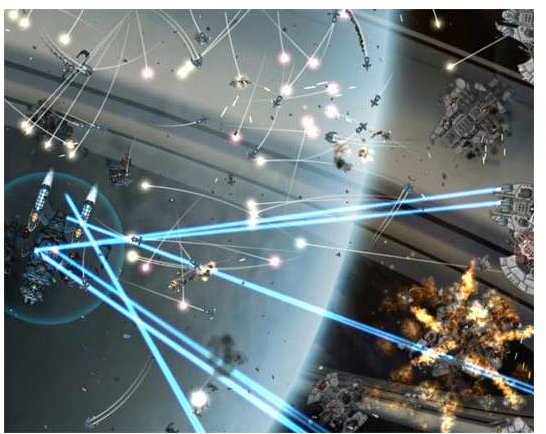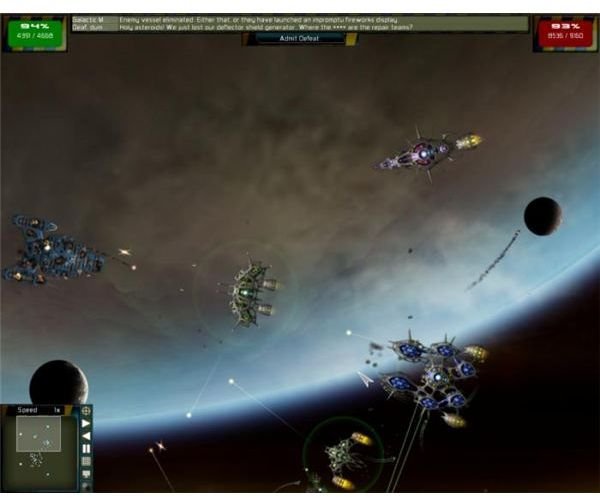Gratuitous Space Battles Guide: Weapons and Armor Strategy

A Laser for Your Thoughts
The weapons and armor in Gratuitous Space Battles are the Lego of war. They are what make your ships capable in combat and determine victory or defeat. They can be combined in endless arrays, creating ships which are very strong or very weak.
In this guide we’ll explore the different categories of weapons and armor in the game and try to find the best way to determine what components are appropriate for a given situation.
Weapon Damage and Speed
A cruiser without a big cannon is a sad, sad cruiser. But how can you determine which cannon is the best one to mount?
The most basic indicator of a weapon is the damage stat. This is simply how much damage it does to a ship’s hitpoints. The second basic indicator is fire interval. Fire interval seems to be calculated so that each unit of fire interval equals two milliseconds. For example, a weapon with a fire interval of 500 will fire every second. Using this information the damage per second can be calculated. The Cruiser Pulse Laser (this is an easy one) does ten damage and fires at an interval of 500 (or once per second). The result is ten damage per second. Obviously a weapon with a high rate of damage per second is preferable, but there is more to picking a weapon than mere damage per second.
Armor and Shield Penetration
Weapons also have shield and armor penetration stats. These penetration stats are important because they modify the damage done. If they are not considered, it is possible to build a ship which is literally incapable of damaging enemy vessels.
In the case of shield resistance, the stat seems to be a simple on-off switch. If a weapon’s shield penetration is not higher than an enemy’s shield resistance, the weapon does no damage, no matter what its theoretical damage per second might be. If the shield penetration is equal to or higher than the shield resistance the weapon does full damage.
Armor is more complex. If a weapon’s armor penetration is lower than an opponent’s armor, no damage is done. However, when damage is done to armor, it reduces the armor’s value by the damage done. For example, a cruiser with armor resistance of 30 is invulnerable to a weapon with an armor penetration of 20. But if another weapon penetrates the armor and does 11 points of damage, the armor resistance will now be 19, and shots with a penetration rating of 20 will get through. This is why armor tends to fail suddenly and dramatically - once a big hole is created in the armor, the small shots which were previously trivial suddenly get through. Armor also has a damage absorbable stat. This is basically a hitpoint bonus and represents how much damage the armor can take before it is destroyed. Armor takes damage before a ship’s hull and components, except in the case of critical hits.
More Weapon Considerations

There are a few other things to consider about weapon components.
Tracking speed is a rather vague stat which expresses how quickly a weapon can track enemy vessels. It is important in determining how well a weapon will do against a fast moving ship. For example, Plasma Launchers have very poor tracking speeds which make them inappropriate for trying to shoot down fighters or even some of the faster frigates.
All weapons also have size, power, and space requirements, as do any other module. These requirements must be carefully balanced. Missiles tend to be heavy on crew requirements while lasers tend to be heavy on power requirements. Weight also is a consideration. Heavy weapons will slow a ship down.
One thing which is not reflected in weapon stats is that missile weapons do not fire another salvo until the first has made impact or has been scrambled or destroyed. As a result of this, missile weapons tend to do a lot less damage over time when used at long ranges rather than at medium ranges. There is some logic in ordering missile ships to get into knife fights.
General Recommendations
Shields and armor work well together, but shields are usually superior. They recharge and they are not subject to the sudden and dramatic failures which plague armor. However, armor isn’t worthless. It is particularly good against fighters, which are able to bypass shields. There are also some scenarios where the effectiveness of shields are reduced.
Offensively, weapons which gear towards shield penetration are usually better than those which gear towards armor penetration simply because shielding is often tougher to get through than armor.
Keep in mind however, that these are only general recommendations. There is a huge variety of potential ship designs and fleet deployments in the game, and there are exceptions to these rules.
